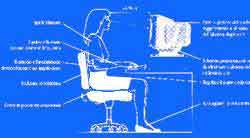
The object of this research is "The scientific survey as an instrument of knowledge of architecture and the city", therefore also the survey, like all work tools, cannot fail to take into account the laws of ergonomics.
1 - Reading the relief.
What are the working conditions of the survey user? At present, in almost all cases, the relief is provided on paper, with large format sheets, which, for reading, require a large support surface and continuous user mobility. The ergonomic logic, on the other hand, provides for the user a comfortable chair, a certain inclination of the head, the positioning of a screen at an optimal viewing distance, within a very precise visual cone. The digital representation allows compliance with all these conditions, by scrolling on the screen all the existing information (texts, photographs and interactive drawings) and ensuring, thanks to the Internet, the usability of the same from multiple workstations, also placed at a great distance. one from the other.
2 - The instruments for the survey.
The use of new technologies, undoubtedly, has opened new horizons to the detector, but these, often for lack of professionalism, lose sight of the final objective of the survey itself. Let's examine some tools:
2.1 - photography. The existence on the market of a wide range of lenses and their improper use has given little credibility to the photographic documentation: just think of the indiscriminate use of wide-angle lenses, which, in addition to altering the representation of reality, are often used for the editing of photomosaics.
2.2 - stereoscopy. The base/distance ratio, in photogrammetric shooting, should not go beyond 1/5 (already uncomfortable enough), which corresponds to the average ratio between our interpupillary distance (6-7 cm.) And the minimum distance of observation (25 cm.). The advent of digital photogrammetry, albeit for the purpose of improving accuracy, has pushed this ratio down to 1/2, which would suggest that man can stereoscopically observe an object placed at 6 cm. from the eyes (you just have to try!).
2.3 - photogrammetric shooting. The use of the normal case, in photogrammetry, has the same motivations as the use of the normal lens in photography. It is simply a matter of allowing the user to observe the photographic model in conditions similar to those with which he is accustomed to observing the reality in which he lives. Today, however, recourse to convergent axes is increasingly used, an immediate consequence of the use of a non-ergonomic base / distance ratio or the incorrect similarity of the camera to the human eye. In any case, this shooting condition, by varying the background existing behind the photographed object on the two frames, effectively prevents stereoscopic observation.
2.4 - The electronic theodolite. The elimination of the "country book" in the relief is a great achievement and this the electronic theodolite allows it, but the illusion of reducing the relief of architecture to the relief of a set of points, however large, represents a very serious misunderstanding. Today, thanks to the digital metric cameras, with the help of a laptop and a good programming job, the electronic theodolite already allows the testing of the shot in the countryside and, therefore, it is unthinkable to continue to carry out the photogrammetric recording and the survey of the support points independently of each other.